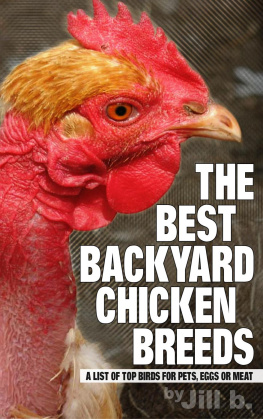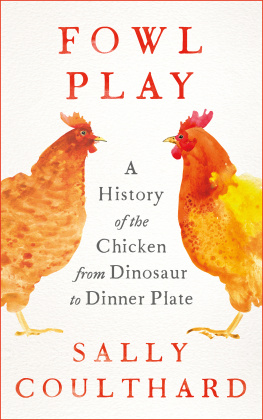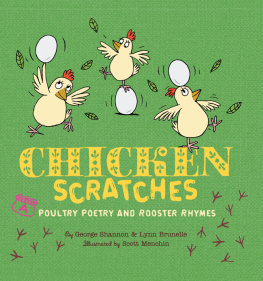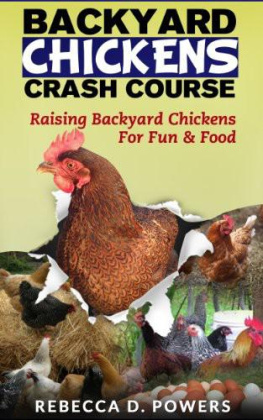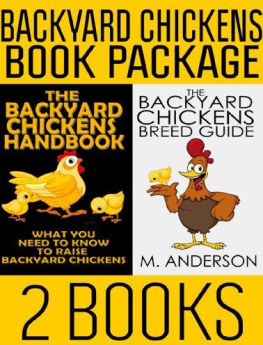
THE
MAGNIFICENT
CHICKEN
Portraits of the Fairest Fowl
PHOTOGRAPHS BY TAMARA STAPLES
Essay by Ira Glass
Text by Christa Velbel and Tamara Staples


Early 20th-century chicken photo by Arthur Schilling .
Photography copyright 2001, 2012 by Tamara Staples.
Text copyright 2001 by Christa Velbel.
Additional text copyright @ 2013 by Tamara Staples.
Trying to Respect a Chicken was broadcast on the public radio program This American Life , produced at WBEZ in Chicago and distributed by Public Radio International. Produced by Julie Snyder. Copyright by Ira Glass and WBEZ Chicago. 1997. Used by permission.
All rights reserved. No part of this book may be reproduced in any form without written permission from the publisher.
Library of Congress Cataloging-in-Publication Data available.
ISBN: 978-1-4521-2562-6
Designed by The Grillo Group, Inc. www.grillogroup.com
Additional design by Anne Kenady.
Additional credits:
Photo on provided by Bill Wulff, Poultry Press , photo by Arthur Schilling.
New feather and all globe illustrations, by Scott Piper.
Text on from the American Standard of Perfection , 1910 edition. Used by permission of the American Poultry Association.
Photo on by Bill Newell.
Chronicle Books LLC
680 Second Street
San Francisco, CA 94107
www.chroniclebooks.com
INTRODUCTION
to the new edition
I began photographing chickens more than ten years ago. In 2001, when The Fairest Fowl was first published, there was little information available about poultry shows. Since that time these chickens have become a more familiar and beloved sight. There are record numbers exhibiting at the shows. City laws have relaxed to allow backyard chicken coops. New books and magazines about raising and breeding backyard chickens have become available. And Martha Stewart honored the chicken by using chicken names for paint colors. Needless to say, the fancy chicken has arrived.
After The Fairest Fowl , when thinking about other subjects I wanted to photograph, I just kept coming back to the chickens. Theres really no reason other than pure love. As more time passed, I became curious as to what had changed about the poultry shows, the birds, and the people. As I moved back into their world, I found that, happily, little had changed. People are still devoted to raising the perfect specimen. The birds are as magnificent as I remember. I am happy to report that The Fancyas the shows are known to their devoteesis alive and well. Thriving, in fact. In this new revised and expanded book youll find twenty new chickens, new glimpses into the shows, and a new resource section. I am so pleased to present to you a rare peek inside a world that few outsiders ever see. I hope it delights and amazes you.

CONTENTS
Ira Glass, This American Life .
The experiences and insights of the host of Public Radio Internationals This American Life during one of Tamaras chicken photo shoots.
Getting up-close and personal with the amazing chickens of the poultry show circuit.
On judgment day, chickens of every national origin march (or strut) to this tune.
Pictures of perfection, or something very near it, at least. Prize-winning chickens and what makes them that way.
TRYING TO
RESPECT A CHICKEN
BY IRA GLASS
This American Life



In a way, it is like Tamara Staples is running an odd little cross-species science experiment that asks this question: What happens when you try to treat a chicken the way we treat humans, even if it is just for the length of a photo shoot?
What happens, it turns out, is you learn just what the thin line is that divides human beings from birds. Maybe its not just a thin line, but it is definitely a line. And like most city people, I had never thought about itabout where it lies, about what it might be, about what it might consist ofuntil Tamara and I headed out to a farm.
Outdoor sound, chickens clucking .
PAUL: I think that is the best one.
TAMARA: Yeah, weve got to get him. We dont want him to get dirty, do we? Or does it matter?
PAUL: She runs loose every day.
TAMARA: Will we find her again? We are going to have to wrangle her, you know...
We are at the Davidsons dairy farm, about an hour and a half northwest of Chicago. Family members present: Paul, who is helping Tamara choose a bird to photograph; his sister Laura, who is studying photography at a nearby university; their grandfather George Cairns, a veteran breeder; and their father Dick, who seems the most skeptical of this whole project. But he patiently shows Tamara and her assistant the milking barn as a possible place to set up and shoot.
TAMARA: It is a study of the birds, but it is an isolated study so people arent necessarily associating them with the farm and something to eat.
This does not seem to win over the farmers, so Tamara takes us all outside the barn and shows us her shots; as she does, she drops the names of some big chicken people, people whose birds she has photographed, including Bill Wulff, editor and publisher of Poultry Press . Dick notices that a bird in one photo has crooked toes.
IRA: What do you guys think of the pictures?
GEORGE: Oh, the pictures are nice and sharp, I mean, theres nothing wrong with the pictures. If there is anything to find fault with, its the birds.
The fact is, while city people usually go nuts when they see Tamaras pictures, a lot of chicken breeders dont like them. To understand why, to fully comprehend this little culture clash here in America, we have to leave the barnyard for a minute and flash back to something that happened back at Tamaras apartment in the city. Tamara showed me this old, red book from the turn of the century with the seal of the American Poultry Association in gold letters: Standard of Perfection . Tamara flipped through the engravings and illustrations of various types and breeds. These were show chickens standing the way that chickens stand in competitions. Then Tamara pulled out one of her own photos for comparisonto show me how her poses do not meet the Standard .
TAMARA: The tail needs to be higher, she is not standing erect, chest isnt out, head needs to be up more... and you can see the shape of the chicken much better in the
Next page

